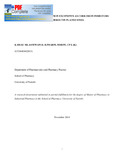| dc.description.abstract | Background: The use of metals in packaging is widespread in both pharmaceutical and food
industries. The most commonly used metals are tin plated steel and aluminium. About 80% of
food cans are made of tin plated steel with increasing use of tin plated steel canisters in the
packaging of pharmaceuticals. Tin is incorporated onto steel because it is non toxic, it acts as a
low friction surface during manufacturing, it resists seam welding, it is recyclable and the fact
that it provides mild atmospheric resistance to corrosion. Tin plated steel cans can rust when in
contact with water. The rate of corrosion/rust varies with the composition of media in contact
with the container.
Objectives: To develop a model system to study corrosion of tin plated steel and to test selected
pharmaceutical excipients for corrosion inhibition properties.
Methodology: Commercially available lacquered tin plated steel sheets obtained from a
container ready for packing pharmaceuticals were cut into 30*30*0.2 mm pieces. The external
side of the tin plated sheet contained clear vanish lacquer rendering it waterproof. The internal
part of the sheet contained an epoxy phenolic lacquer. The amount of tin was 2.8 mg per metre
squared of steel. The pieces were mechanically polished using filter paper, washed with distilled
water, dried between clean filter papers and finally weighed. The tin plated pieces were
immersed in 100 mL of test solution with or without the inhibitor for 72 hours for all excipients
except solvents. After the test, the pieces were removed, washed with distilled water, dried as
before and weighed again. To test for the effect of substitution of distilled water with other
solvents the procedure was as above, but the duration was 14 days. For every concentration of
test solution, only one concentration of pharmaceutical excipient was investigated.
The weight loss of the metal was calculated as follows:
ΔW=W1-W2
Where W1and W2 are the weights of the metal before and after exposure to corrosive solution
respectively.
xiii
The percent Inhibition Efficiency (%IE) was calculated from the equation below:
%IE = [1-(ΔWinh/ΔWfree)]*100
Where ΔWfree and ΔWinh are weight losses of metal in grams per 9 cm2 in the absence and
presence of inhibitor at a given time, period and temperature respectively.
Results: Substitution of distilled water as the vehicle of formulation with Isopropyl alcohol
(IPA) and ethanol at concentration of 20% and 50% for each resulted in substantial corrosion
inhibition. The results obtained indicate that IPA is slightly more effective both at 20% and 50%
concentrations as compared to ethanol at the same concentrations.
In alkaline media of 0.01N NaOH, 0.1N NaOH and 1N NaOH, the inclusion of ascorbic acid
(0.1% and 0.5%), EDTA (0.5% and 2%) Avicel (2% and 5%) and gelatin (2% and 5%) in each
of the concentrations resulted in corrosion inhibition to varying degrees. An increase in
concentration of the excipients resulted in an increase in Percentage Inhibitor Efficiency (% IE).
The above excipients when incorporated in alkaline formulation packed in tin plated steel can be
of help in inhibiting corrosion of tin plated steel.
In acidic media, the inclusion of ascorbic acid (0.1% and 0.5%), EDTA (0.5% and 2%) Avicel
(2% and 5%) and gelatin (2% and 5%) in test media resulted in corrosion inhibition to varying
degrees. An increase in concentration of the excipients resulted in an increase in Percentage
Inhibitor Efficiency (% IE). The above excipients when incorporated in acidic formulation
packed in tin plated steel can be of help in inhibiting corrosion of tin plated steel.
In chloride solution, inclusion of ascorbic acid (0.1% and 0.5%), EDTA (0.5% and 2%), Avicel
(2% and 5%) and gelatin (2% and 5%) in test media resulted in corrosion inhibition to varying
degrees. An increase in concentration of the excipients resulted in an increase in Percentage
Inhibitor Efficiency (% IE). The above excipients when incorporated in chloride containing
formulations packed in tin plated steel can be of help in inhibiting corrosion of tin plated steel.
Conclusion: Ascorbic acid (0.1% and 0.5%), EDTA (0.5% and 2%), Avicel (2% and 5%) and
gelatin (2% and 5%) can be incorporated in acidic formulations, alkaline formulations or
formulations containing chloride ions in tin plated steel containers as corrosion inhibitors.
Substitution of distilled water with ethanol or isopropyl alcohol as vehicle for formulation, where
xiv
possible, is also a good strategy in inhibition of corrosion of tin plated steel. Sodium
Metabisulphite should be avoided in acidic, alkaline or chloride containing formulations that are
to be packed in tin plated steel. Sodium Lauryl Sulphate has minimal value as a corrosion
inhibitor for tin plated steel in acidic, alkaline or chloride containing formulations.
Recommendations: Combinations of EDTA, Avicel, Gelatin and Ascorbic acid should be tested
for synergistic corrosion inhibition activity of tin plated steel in acidic, basic and chloride
systems .These combinations may also be tested in systems containing mixtures of acidic, basic
and chloride ions. | en_US |
| dc.description.department | a
Department of Psychiatry, University of Nairobi, ; bDepartment of Mental Health, School of Medicine,
Moi University, Eldoret, Kenya | |

